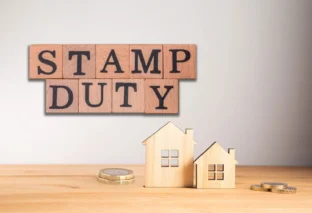Do First Time Buyers Pay Stamp Duty? A Guide for Homebuyers
28 April 2025 • 8 min read

See what our customers have to say about us
Do first-time buyers pay stamp duty for their home purchase?
Several factors determine the need to pay Stamp Duty Land Tax on top of the huge cost associated with buying your first home. For instance, the property price, date of purchase, and government regulations.
In this article, you’ll get a better understanding of what is first-time buyer stamp duty, specifically how it will affect your property buying decision. You’ll learn how the UK stamp duty thresholds have changed and what you can do to adjust your budget plans.
An Overview of Stamp Duty for First-Time Buyers
Stamp Duty Land Tax, or SDLT for short, refers to the government tax imposed on property purchases in England and Northern Ireland.
A first-time buyer’s SDLT comes with specific reliefs meant to make property buying more affordable through reduced tax rates. It aims to encourage more first-time homebuyers despite the rising property prices.
Find out what first-time buyers can avail so you can avoid unexpected costs and ensure your budget won’t fall short as you complete the property transaction.
Understanding Stamp Duty Land Tax (SDLT)
SDLT is a lump sum payment to the government when a residential or commercial property is bought. Property buyers, through their solicitors, are responsible for paying this within 14 days after the completion date. SDLT rates are tiered. Your payment depends on the property price and the circumstances surrounding the transaction.
For instance, the SDLT payment of a first-time buyer would differ from someone buying their second property.
First Time Buyer thresholds from 1 April 2025
Starting 1st April 2025, SDLT thresholds will revert to the original level (after being reduced temporarily back in September 2022).
First-time buyers will follow these SDLT rates from property purchases:
- 0% for properties worth £300,000 or less
- 5% for properties worth £300,001 to £500,000
Any property beyond these values will follow the standard SDLT rate for buyers of main residences (not first-time buyers).
Find out if first-time buyers need to pay stamp duty, and how much they can owe.
Are First-Time Buyers Required to Pay Stamp Duty?
Don’t assume there’s no stamp duty for first-time buyers. You still have to pay stamp duty, as long as certain conditions are met.
Based on the SDLT threshold as of 1st April 2025, as long as the property you’re buying is no more than £300,000, you’re exempt from paying stamp duty.
However, if you buy a property worth £300,001 to £500,000, you’ll have a reduced rate of 5%.
Stamp Duty Exemption for First-Time Buyers
The exemption for first-time buyers is an effort made by the government to make homebuying more affordable. Buyers have to meet certain conditions to be exempt from paying stamp duty, leading to significant savings in the homebuying process.

Stamp Duty Reliefs and Thresholds
The UK government provided SDLT relief and thresholds to address issues of affordability for homebuying. First-time buyers, in particular, struggle to fund the high upfront costs associated with buying a first property.
Based on the SDLT tax manual, this relief is only available to:
- Buyers who never owned a property before (in the UK or anywhere in the world)
- Buyers purchasing a residential property in either England or Northern Ireland that’s no more than £500,000
- Buyers who plan to live in the property as their main residence
The buyers should be considered as individuals. If the transaction is a joint purchase, all individuals involved should be first-time buyers. The purchase should not be linked to other land transactions unless it’s a part of the single dwelling (property) being bought.
First-Time Buyer Relief Savings
Here’s an example of how the First-Time Buyer Relief brings savings.
If you’re buying a home for £400,000, your SDLT will cost £5,000. The breakdown is as follows:
- 0% on the first £300,000
- 5% on the last £100,000, or £5,000
Without the relief, your SDLT will cost £10,000. The breakdown is as follows:
- 0% on the first £125,000
- 2% on the next £125,001 to £250,000, or £2,500
- 5% on the last £250,001 to £400,000, or £7,500
Thanks to the First-Time Buyer Relief, you’ll get a £5,000 savings on the £400,000 property.
Calculating Stamp Duty for First-Time Buyers
Calculating the cost of your stamp duty land tax payment can be confusing because of the tiered rates. A closer look at the process would help you understand how you save money through the first-time buyer’s relief.
Stamp Duty Calculation Process
The calculate the SDLT fee of first-time buyers, follow these steps.
- Check the current SDLT rates. As of 1st April 2025, the rate is 0% for properties worth £300,000 or less and 5% for properties worth £300,001 to £500,000.
- Get the purchase price of the property. If the property is less than £300,000, there’s no need to calculate the SDLT.
- If the property is between £300,001 and £500,000, calculate 5% of the amount above £300,000.
- If the property is more than £500,000, the standard SDLT rates for main residences will apply.
Here are examples of SDLT payments for first-time home purchases.
- £250,000 property = £0 SDLT
- £350,000 property = 5% of £50,000 = £2,500 SDLT
- £550,000 property = Standard SDLT rates apply: 0% of £125,000, 2% of the next £125,000 (£2,500) and 5% of the last £300,000 (£15,000) = £17,500 SDLT
Stamp Duty Calculator
The HMRC SDLT calculator is available to help property buyers estimate their SDLT payments. When using the calculator, be careful when answering the questions, specifically when it comes to your status as a buyer.
Impact of Property Prices and Types
Several factors affect your SDLT payments. Since it follows a tiered rate, the property price will affect the amount you’ll pay. The property type is also an important consideration when calculating your stamp duty land tax dues.
Property Purchase Price
There are three simple SDLT rules when it comes to the property purchase price.
- If the property is £300,000 or less, you don’t need to pay SDLT.
- If the property is between £300,001 to £500,000, you need to calculate 5% of the amount beyond £300,000. The amount derived is the SDLT payment.
- If the property is more than £500,000, the property purchase is not qualified for First-Time Buyers Relief. The SDLT will follow the standard rates for main residences.
Property Type Considerations
The SDLT rate for first-time buyers is only applied to residential properties. Buying commercial properties or mixed-use properties (even if it’s partly a residence) won’t qualify you for First-Time Buyers Relief. This means certain property types will affect your SDLT payments.
Buying shared ownership homes can qualify for the relief, as long as everyone is a first-time buyer. Otherwise, your SDLT payments will be higher as they will follow standard rates.
Inherited properties are not qualified as well, since this will not make you a first-time buyer.
Buy-to-let properties are considered investment assets. Since you won’t live in it, this won’t qualify for First-Time Buyers Relief.
Leasehold properties also follow a different set of rates compared to freehold properties. Use the government’s SDLT calculator for a more accurate estimate of your SDLT payments.

Government Schemes and Support
What happens if your property purchase does not qualify for First-Time Buyer’s Relief? There are still ways to make your SDLT payments lower. Some government schemes are in place to help property buyers with stamp duty payments.
Buyer Stamp Duty Relief
Here are other scenarios where stamp duty relief can be applied:
- A property bought qualifies as a Right to Buy transaction.
- A property is bought for charitable purposes.
- A property bought is in a designated Freeport tax site.
- A property is bought by a non-UK resident who’s employed by the Crown.
- A property is bought by a building company (or property trader) from the owner who is buying a new home being developed.
- A property is bought by an employer from the employee (as part of their work, e.g. relocation).
Find out more about Stamp Duty Land Tax relief.
Understand the costs involved—learn whether first-time buyers pay stamp duty.
Comply With First-Time Buyer’s Stamp Duty Obligations
As a first-time buyer, you have the privilege of enjoying reduced SDLT rates, as long as your purchase meets certain requirements. Use these to your advantage, especially as you negotiate the price with sellers. For instance, if a property is more than £300,000, you may want to negotiate that price so you end up not paying SDLT.
Stay up to date on the latest regulations before making a property purchase. Sometimes, the right timing will lead to significant savings.
If you need help navigating the complex world of property buying, contact Muve. We offer expert conveyancing services tailored for first-time buyers.

You might also like
Winter may be considered the "silent period" for real estate, but it can offer ...
Stamp Duty Land Tax (SDLT) rates in England will increase from April 1, 2025, ...

